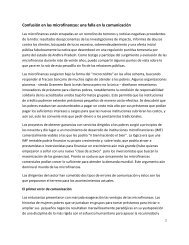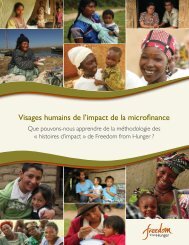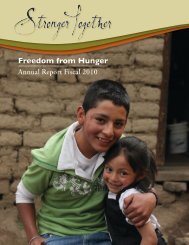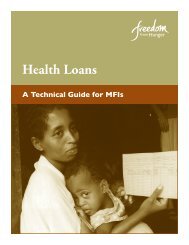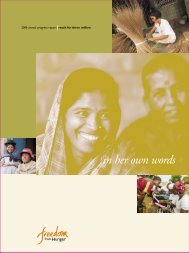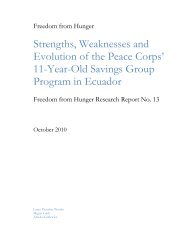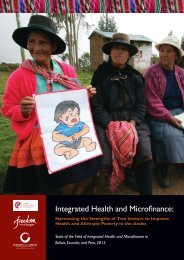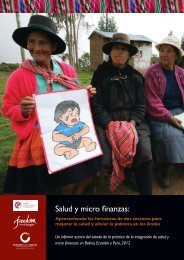history of meals for millions, soy, and freedom from ... - SoyInfo Center
history of meals for millions, soy, and freedom from ... - SoyInfo Center
history of meals for millions, soy, and freedom from ... - SoyInfo Center
Create successful ePaper yourself
Turn your PDF publications into a flip-book with our unique Google optimized e-Paper software.
exist <strong>for</strong> such a book about this very interesting <strong>and</strong><br />
important man.<br />
Contents: List <strong>of</strong> tables (4 tables). 1. Introduction. 2.<br />
Multi-Purpose Food <strong>and</strong> the origins <strong>of</strong> the Meals <strong>for</strong><br />
Millions Foundation. 3. Meals <strong>for</strong> Millions: Constitutional<br />
development <strong>and</strong> internal structure. 4. Conflict <strong>and</strong><br />
cooperation within the United States. 5. HMF <strong>and</strong> the<br />
United States government. 6. Meals <strong>for</strong> Millions <strong>and</strong> the<br />
United Nations Children’s Fund [UNICEF]. 7. Meals <strong>for</strong><br />
Millions overseas. 8. New leadership <strong>and</strong> new policies. 9.<br />
Conclusion. Bibliography.<br />
Introduction: This is a study <strong>of</strong> an international nongovernmental<br />
organization (NGO). Although there are<br />
thous<strong>and</strong>s <strong>of</strong> NGOs that operate internationally, they have<br />
captured the attention <strong>of</strong> only relatively few scholars.<br />
“NGO’s represent the ‘un<strong>of</strong>ficial side <strong>of</strong> world affairs’ in<br />
counter-distinction to the <strong>of</strong>ficial government side reflected<br />
by such intergovernmental organizations (IGO’s as the<br />
United Nations, the Organization <strong>of</strong> American States, <strong>and</strong><br />
the European Economic Community).” The United Nations<br />
<strong>and</strong> its specialized agencies have, since 1945, concluded a<br />
host <strong>of</strong> “consultative agreements” (as provided in Article 71<br />
<strong>of</strong> the UN charter); the United Nations has concluded such<br />
agreements with 297 NGO’s, UNICEF with 57, FAO with<br />
40, <strong>and</strong> WHO with 46.<br />
Lyman C. White, in his book on “International Non-<br />
Governmental Organizations:... (1951, p. 10), observes that<br />
they are frequently “pioneers–the first to recognize a need,<br />
the first to do something about it, either in study <strong>and</strong><br />
research or in a program <strong>of</strong> action.”<br />
“In brief, MFM is a small non-pr<strong>of</strong>it organization<br />
founded to provide famine relief <strong>and</strong> to promote a scientific<br />
approach to the prevention <strong>of</strong> starvation. The Foundation<br />
pursues its first objective by distributing an American<br />
produced, low-cost, <strong>soy</strong>bean protein food, Multi-Purpose<br />
Food (MPF), in countries whose people suffer <strong>from</strong> chronic<br />
malnutrition or undernourishment... MFM works toward its<br />
second <strong>and</strong> infinitely more difficult goal by attempting to<br />
stimulate the <strong>for</strong>mulation <strong>and</strong> production <strong>of</strong> MPF or MPFtype<br />
foods in <strong>for</strong>eign countries” (p. 3-4).<br />
Walter H. Pawley <strong>of</strong> FAO’s Freedom <strong>from</strong> Hunger<br />
Campaign wrote in 1963, “up to half the population <strong>of</strong> the<br />
world continues to suffer <strong>from</strong> under-nutrition <strong>and</strong><br />
malnutrition in varying degrees” (p. 4).<br />
“MFM’s ef<strong>for</strong>ts to combat starvation fit into the much<br />
broader struggle by the majority <strong>of</strong> the worlds population to<br />
secure a decent st<strong>and</strong>ard <strong>of</strong> living.”<br />
“Two research considerations also made Meals <strong>for</strong><br />
Millions an attractive subject <strong>for</strong> a study <strong>of</strong> an NGO. First...<br />
[it] has numerous contacts with the representatives <strong>of</strong><br />
governmental, non-governmental, <strong>and</strong> intergovernmental<br />
organizations as well as citizens <strong>of</strong> over one hundred<br />
countries... Secondly, the <strong>of</strong>ficers <strong>of</strong> Meals <strong>for</strong> Millions<br />
agreed to make available all their records <strong>and</strong><br />
MEALS FOR MILLIONS, SOY, AND FREEDOM FROM HUNGER 81<br />
© Copyright Soyinfo <strong>Center</strong> 2011<br />
correspondence including that <strong>of</strong> a confidential nature. This<br />
commitment, which was more than fulfilled during the<br />
summer <strong>of</strong> 1962, permitted the writer to review the<br />
multitudinous correspondence, reports, transcripts <strong>and</strong> notes<br />
<strong>of</strong> interviews,... <strong>and</strong> financial records kept <strong>of</strong> file at the Los<br />
Angeles headquarters <strong>of</strong> the Foundation. Key <strong>of</strong>ficers <strong>of</strong> the<br />
Foundation including its president, one <strong>of</strong> its vice<br />
presidents, its research director, its executive director, its codirector<br />
<strong>and</strong> secretary plus important members <strong>of</strong> the staff<br />
made themselves available <strong>for</strong> at least one <strong>and</strong> frequently<br />
more interviews. The writer was also permitted to observe<br />
the day-to-day operations <strong>of</strong> the headquarters <strong>of</strong>fice, attend<br />
staff meetings, listen to an executive council session, <strong>and</strong><br />
become fairly well-acquainted with the ‘tone’ <strong>of</strong> the<br />
Foundation” (p. 6).<br />
Chapter 2, “Multi-Purpose Food <strong>and</strong> the origins <strong>of</strong> the<br />
Meals <strong>for</strong> Millions Foundation, begins (p. 8): “Meals <strong>for</strong><br />
Millions Foundation was incorporated in the State <strong>of</strong><br />
Cali<strong>for</strong>nia on 5 July 1946 because the aspirations <strong>of</strong> its<br />
President, Clif<strong>for</strong>d E. Clinton, became linked to the<br />
existence <strong>of</strong> the vegetable protein food supplement, Multi-<br />
Purpose Food.” There follows the story <strong>of</strong> Mr. Clinton’s life<br />
<strong>and</strong> work.<br />
When he moved to Los Angeles to establish a<br />
restaurant, he “decided to apply a principle <strong>of</strong> ‘practical<br />
Christianity’ <strong>and</strong> never to refuse a meal to a person who<br />
could not pay <strong>for</strong> it. Since the [Great] depression was<br />
beginning to gain momentum, there were many residents <strong>of</strong><br />
Los Angeles who fitted into this category. Indeed, during<br />
the first sixty days <strong>of</strong> business Clinton’s restaurant served<br />
nearly 10,000 who could not pay <strong>for</strong> their food. This<br />
number far exceeded that <strong>of</strong> paying customers <strong>and</strong><br />
obviously presented a challenge to Clinton’s ideal.<br />
However, Clinton believed that if the ideal were valid then<br />
there had to be a way <strong>of</strong> achieving it. Working on this<br />
assumption, Clinton went to the various concerns that<br />
supplied his restaurant <strong>and</strong> asked them to sell their food to<br />
him at cost. The food suppliers, who had plenty <strong>of</strong> food but<br />
no buyers, agreed to Mr. Clinton’s request. Many <strong>of</strong> them,<br />
in fact, exceeded their initial promise by giving Clinton<br />
quantities <strong>of</strong> food they could not sell. Clinton then set up a<br />
basement cafeteria where each item <strong>of</strong> food could be<br />
purchased <strong>for</strong> one cent. Volunteers helped serve the food,<br />
the local musicians’ union supplied an orchestra <strong>of</strong><br />
unemployed musicians free <strong>of</strong> charge to provide<br />
entertainment, <strong>and</strong> artists donated their talents to decorate<br />
the cafeteria. Next he sold tickets <strong>for</strong> a penny a piece to<br />
regular paying customers who when asked <strong>for</strong> a meal by<br />
someone on the street would give them a few tickets with<br />
directions... to Clifton’s cafeteria. Mr. Clinton continued this<br />
system <strong>of</strong> relief throughout most <strong>of</strong> World War II” (p. 8-9).<br />
“With the entry <strong>of</strong> the United States into World War II,<br />
Clinton [now age 42] set aside plans <strong>for</strong> expansion in order<br />
to enlist in the army. But he soon received an honorable



